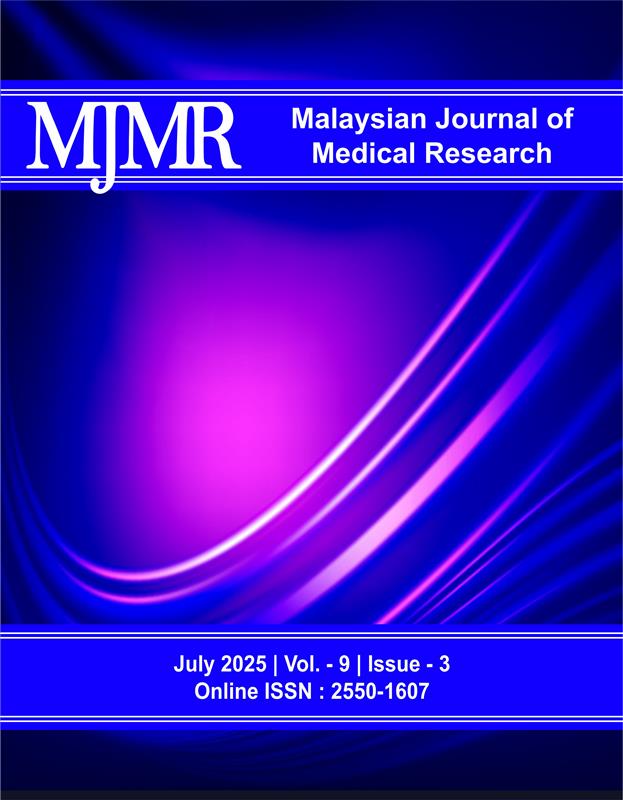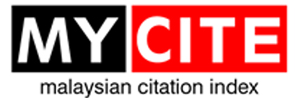Knowledge and Attitude Towards Cone Beam Computed Tomography (CBCT) Among Undergraduate Dental Students in Malaysia – A Questionnaire Survey
DOI:
https://doi.org/10.31674/mjmr.2025.v09i03.007Abstract
Introduction: This study investigates the knowledge and attitudes of undergraduate dental students in private universities in Klang Valley, Malaysia, towards cone beam computed tomography (CBCT). Objective: The aim of this study was to assess the knowledge and attitude towards cone beam computed tomography (CBCT) among undergraduate dental students in private universities in Klang Valley, Selangor, Malaysia. Methods: A questionnaire consisting of 14 close ended questions was given to 250 undergraduate dental students in private universities in Klang Valley. The chi-square test was used to statistically analyse the differences in responses based on educational level. Results: A total of 182 participants responded to this study. All of the participants consisting of 39 year 3 students (21.4%), 70 year 4 students (38.5%) and 73 year 5 students (40.1%) were aware of CBCT (100%). 82.4% (n = 152) obtained information regarding CBCT by internet, 69.2% by (n = 119) by faculty lessons and 54.4% (n = 88) through seminars. 64.5% (n = 118) thought that faculty was not providing adequate education regarding CBCT and 97.3% (n = 177) thought that CBCT should be part of the undergraduate curriculum, specifically in the clinical phase (76.4%, n = 139). 78.6% (n = 143) thought that it is necessary for a CBCT unit to be available at their faculty. 60.4% (n = 110) believed that CBCT will be used in all areas of dentistry in the future. 91.8% (n = 167) planned to use CBCT in their future professional career and 79.7% (n = 145) would take the initiative to update themselves regarding information on CBCT from time to time. Conclusion: This research suggests more emphasis should be given on CBCT in dental school curriculum and effort should be made to improve student’s basic knowledge, understanding and practical training for better interpretation in routine clinical practice.
Keywords:
Attitude, Cone Beam Computed Tomography, Dental Students, KnowledgeDownloads
References
Alharbi, H. H. O., Al-Dubai, S. A. R., Almutairi, R. M. H., & Alharbi, M. H. (2022). Stigmatization and discrimination against people living with HIV/AIDS: Knowledge, attitudes, and practices of healthcare workers in the primary healthcare centers in Madinah, Saudi Arabia, 2022. Journal of Family and Community Medicine, 29(3), 230-237. https://doi.org/10.4103/jfcm.jfcm_136_22
Asrina, A., Ikhtiar, M., Idris, F. P., Adam, A., & Alim, A. (2023). Community stigma and discrimination against the incidence of HIV and AIDS. Journal of Medicine and Life, 16(9), 1327. https://doi.org/10.25122/jml-2023-0171
Bin Ahmad, M. Z., Md. Yasin, M., Mat Nasir, N., & Mohamad, M. (2024). The association between HIV-related stigma, HIV knowledge and HIV late presenters among people living with HIV (PLHIV) attending public primary care clinic settings in Selangor. Plos One, 19(7), https://doi.org/10.1371/journal.pone.0306904
Chan, H. N., Mohamad, A., Rashid, A. A., Ho, B. K., Cooper, A. A. A., Aajamer, H. M., ... & Hwee, G. N. L. (2022). Assessing knowledge, acts of discrimination, stigmatizing attitudes and its associated factors towards people living with HIV (PLHIV) among Family Medicine trainees in Malaysia. Malaysian Family Physician: the Official Journal of the Academy of Family Physicians of Malaysia, 17(3), 33. https://doi.org/10.51866/oa1298
Chan, Y. C., binti Mawardi, M., & Ismail, A. H. (2021). Stigmatizing attitudes toward people living with HIV/AIDS (PLWHA) among primary health care providers in Kinta District, Perak. Malaysian Family Physician: The Official Journal of the Academy of Family Physicians of Malaysia, 16(1), 31–38. https://doi.org/10.51866/oa0001
Chew, B. H., & Cheong, A. T. (2013). Assessing HIV/AIDS knowledge and stigmatizing attitudes among medical students in Universiti Putra Malaysia. The Medical Journal of Malaysia, 68(1), 24-29. Retrieved from: https://europepmc.org/article/med/23466762. Accessed on 18th July 2024.
Fauk, N. K., Hawke, K., Mwanri, L., & Ward, P. R. (2021a). Stigma and discrimination towards people living with HIV in the context of families, communities, and healthcare settings: a qualitative study in Indonesia. International Journal of Environmental Research and Public Health, 18(10), 5424. https://doi.org/10.3390/ijerph18105424
Fauk, N. K., Ward, P. R., Hawke, K., & Mwanri, L. (2021b). Cultural and religious determinants of HIV transmission: A qualitative study with people living with HIV in Belu and Yogyakarta, Indonesia. PLoS One, 16(11). https://doi.org/10.1371/journal.pone.0257906
Fauk, N. K., Ward, P. R., Hawke, K., & Mwanri, L. (2021c). HIV stigma and discrimination: perspectives and personal experiences of healthcare providers in Yogyakarta and Belu, Indonesia. Frontiers in Medicine, 8. https://doi.org/10.3389/fmed.2021.625787
Frescura, L., Godfrey-Faussett, P., Feizzadeh, A., El-Sadr, W., Syarif, O., Ghys, P. D., & 2025 Testing Treatment Target Working Group. (2022). Achieving the 95 95 95 targets for all: A pathway to ending AIDS. PloS One, 17(8). https://doi.org/10.1371/journal.pone.0272405
Gao, X., Wu, Y., Zhang, Y., Zhang, N., Tang, J., Qiu, J., Lin, X., & Du, Y. (2012). Effectiveness of school-based education on HIV/AIDS knowledge, attitude, and behaviour among secondary school students in Wuhan, China. PloS One, 7(9). https://doi.org/10.1371/journal.pone.0044881
Garett, R., & Young, S. D. (2022). The impact of misinformation and health literacy on HIV prevention and service usage. Journal of the Association of Nurses in AIDS Care, 33(1), e1-e5. https://doi.org/10.1097/JNC.0000000000000298
Goh, K. L., Chua, C. T., Chiew, I. S., & Soo-Hoo, T. S. (1987). The acquired immune deficiency syndrome: A report of the first case in Malaysia. The Medical Journal of Malaysia, 42(1), 58–60. Retrieved from: https://citeseerx.ist.psu.edu/document?repid=rep1&type=pdf&doi=e9aadf61cc88080cbb8658002f9b52c69b235201. Accessed on 28th August 2024.
Hasanah, C. I., Zaliha, A., & Mahiran, M. (2011). Factors influencing the quality of life in patients with HIV in Malaysia. Quality of Life Research, 20(1), 91–100. https://doi.org/10.1007/s11136-010-9729-y
Lazarus, J. V., Safreed-Harmon, K., Kamarulzaman, A., Anderson, J., Leite, R. B., Behrens, G., ... & Waters, L. (2021). Consensus statement on the role of health systems in advancing the long-term well-being of people living with HIV. Nature Communications, 12(1), 4450. https://doi.org/10.1038/s41467-021-24673-w
Li, L., Liang, L., Lin, C., Wu, Z., & Wen, Y. (2009). Individual attitudes and perceived social norms: Reports on HIV/AIDS‐related stigma among service providers in China. International Journal of Psychology, 44(6), 443–450. https://doi.org/10.1080/00207590802644774
Ministry of Health Malaysia (MOH). (2023). 2023 Global AIDS Monitoring. Ministry of Health Malaysia Disease Control Division. Retrieved from: https://www.moh.gov.my/moh/resources/Penerbitan/Laporan/Umum/Laporan_Global_AIDS_Monitoring_2023.pdf. Accessed on 10th July 2023.
Mohammadifirouzeh, M., Oh, K. M., & Tanner, S. (2021). HIV stigma reduction interventions among health care providers and students in different countries: A systematic review. Current HIV Research, 20(1), 20–31. https://doi.org/10.2174/1570162X19666211206094709
Peña Donati, A., & Laufer, M. (2020). Acquired Immune Deficiency Syndrome. Pediatric Respiratory Diseases: A Comprehensive Textbook, 517-528. https://doi.org/10.1007/978-3-030-26961-6_51
Sallam, M., Alabbadi, A. M., Abdel-Razeq, S., Battah, K., et al. (2022). HIV Knowledge and Stigmatizing Attitude towards People Living with HIV/AIDS among Medical Students in Jordan. International Journal of Environmental Research and Public Health, 19(2), 745. https://doi.org/10.3390/ijerph19020745
Shrestha, P. W., Visudtibhan, P. J., & Kiertiburanakul, S. (2024). Factors associated with HIV-related stigma among healthcare providers at a university hospital in Nepal. Journal of the International Association of Providers of AIDS Care (JIAPAC), 23. https://doi.org/10.1177/23259582241282583
Spence, A. B., Wang, C., Michel, K., Ocampo, J. M., Kharfen, M., Merenstein, D., ... & Kassaye, S. (2022). HIV related stigma among healthcare providers: opportunities for education and training. Journal of the International Association of Providers of AIDS Care (JIAPAC), 21. https://doi.org/10.1177/23259582221114797
Sun, X., Feng, C., Feng, L., Xiao, T., Zhao, X., Liu, H., ... & Zhou, D. (2022). An exploratory transmission mode of HIV/AIDS among older people based on data from multiple sources in China. Scientific Reports, 12(1). https://doi.org/10.1038/s41598-022-20146-2
Swinkels, H. M., Vaillant, A. A. J., Nguyen, A. D., & Gulick, P. G. (2024). HIV and AIDS. StatPearls - NCBI Bookshelf, US. Retrieved from: https://www.statpearls.com/point-of-care/22914. Accessed on 27th August 2024.
Turan, B., Budhwani, H., Fazeli, P. L., Browning, W. R., Raper, J. L., Mugavero, M. J., & Turan, J. M. (2017). How does stigma affect people living with HIV? The mediating roles of internalized and anticipated HIV stigma in the effects of perceived community stigma on health and psychosocial outcomes. AIDS and Behavior, 21, 283-291. https://doi.org/10.1007/s10461-016-1451-5
World Health Organization (WHO). (2024). HIV and AIDS: key facts. World Health Organization. Retrieved from: https://www.who.int/news-room/fact-sheets/detail/hiv-aids. Accessed on 29th August 2024.
Yapıcı, O., & Çağlar, Y. (2024). The Relationship Between HIV/AIDS Knowledge and Stigmatizing Attitudes Towards People Living with HIV/AIDS: An Educational Intervention Study. Risk Management and Healthcare Policy, 2755-2762. https://doi.org/10.2147/RMHP.S489989
Youssef, L., Hallit, S., Sacre, H., Salameh, P., Cherfan, M., Akel, M., & Hleyhel, M. (2021). Correction: Knowledge, attitudes and practices towards people living with HIV/AIDS in Lebanon. PloS One, 16(10). https://doi.org/10.1371/journal.pone.0259359
Published
How to Cite
Issue
Section
License
Copyright (c) 2025 Malaysian Journal of Medical Research (MJMR)

This work is licensed under a Creative Commons Attribution-NonCommercial-NoDerivatives 4.0 International License.























